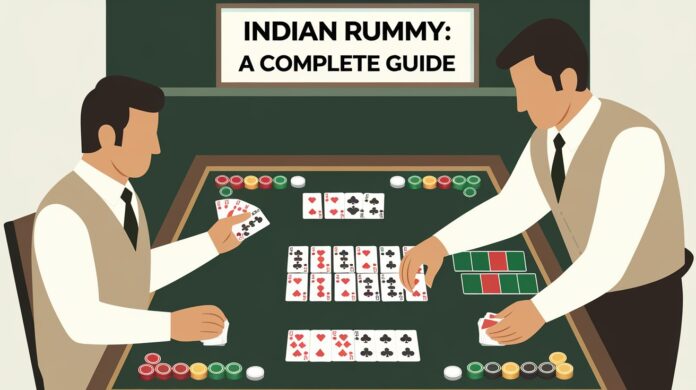Indian Rummy, one of the most popular card games in India, is a variation of the classic Rummy game. Known for its simple yet strategic gameplay, Indian Rummy is played with two decks of cards and is an excellent blend of luck, skill, and strategy. It’s a favorite among families, friends, and even online gaming platforms. Whether you’re a beginner or an experienced player, understanding the rules, strategies, and tips can significantly improve your chances of winning.
In this complete guide, we will take you through how to play Indian Rummy, explaining the rules, card setup, strategies, and common mistakes to avoid. So, grab a deck of cards, and let’s get started!
What Is Indian Rummy?

Indian Rummy is typically played between 2 to 6 players using two standard 52-card decks, and it’s primarily about forming sets and runs. A set consists of three or more cards of the same rank but different suits (e.g., 7 of Hearts, 7 of Spades, and 7 of Diamonds), while a run is a sequence of three or more consecutive cards from the same suit (e.g., 4, 5, 6 of Diamonds). The primary goal in Indian Rummy is to arrange all the cards in your hand into valid sets and runs and “go out” by discarding your last card.
Indian Rummy is played with jokers, which can be used to replace any card in a set or run, adding an extra level of strategy and unpredictability to the game.
Indian Rummy Setup
Indian Rummy is played with the following setup:
- Number of Players: 2-6 players.
- Deck: Two standard 52-card decks are used, making a total of 104 cards.
- Jokers: There are two jokers per deck, which can be used as wild cards to complete sets or runs.
Objective of Indian Rummy
The primary objective in Indian Rummy is to arrange all your cards into valid combinations—sets and runs. To win a round, you must:
- Form at least two sequences (one of which must be a pure sequence).
- Once you have successfully arranged your cards, you can go out by discarding your last card. The round ends at that point.
Indian Rummy Rules
Here’s a step-by-step breakdown of the rules that govern the game:
1. The Deal
- Each player is dealt 13 cards at the beginning of the game.
- The remaining cards form the stockpile (face-down pile), and the top card from the stockpile is placed face-up to start the discard pile.
2. Turn Structure
Players take turns in a clockwise direction, and each turn consists of the following steps:
- Draw a Card: A player starts their turn by drawing a card. They can either pick a card from the stockpile or the discard pile.
- Stockpile: This is the face-down pile from which players draw cards.
- Discard Pile: This is the face-up pile of cards discarded by other players. If the top card in the discard pile is useful, a player can draw it.
- Melding: After drawing a card, players can choose to form sets and runs. This step is optional during a player’s turn, but it’s crucial for reducing your total points in case your opponent goes out.
- Discard a Card: At the end of the turn, the player must discard a single card from their hand onto the discard pile. Discarding the last card signals the end of the round.
3. Melding (Forming Sets and Runs)
Melding refers to the process of arranging your cards into valid combinations—sets and runs:
- Set: A set consists of three or four cards of the same rank but from different suits. For example: 7 of Hearts, 7 of Spades, and 7 of Diamonds.
- Run: A run is a sequence of three or more consecutive cards of the same suit. For example: 4, 5, and 6 of Diamonds.
There are specific requirements in Indian Rummy:
- Players need to form at least two sequences (one of which must be a pure sequence).
- A pure sequence is a run without the use of a joker. A run made with the help of a joker is called an impure sequence.
- If you can form your hand into valid combinations, you can “go out”.
4. Going Out
The round ends when a player goes out. To go out:
- You must have melded all your cards into sets and runs.
- You discard your last card.
Once you go out, your opponent lays down their hand and counts their remaining cards. If their cards are unmelded, they will be penalized based on the points left in their hand.
5. Scoring

After a player goes out, scoring is done as follows:
- Points for Unmelded Cards:
- Number cards (2-10): Worth face value (e.g., a 7 of Hearts is worth 7 points).
- Face cards (J, Q, K): Worth 10 points each.
- Aces: Worth 10 points.
- Jokers: Worth 0 points.
- The Winner: The player who goes out first wins the round and receives the difference in points between their hand and their opponent’s hand.
Tip: The best way to win is to get rid of your cards early, keep your deadwood low, and try to force your opponent into a situation where they can’t form valid combinations.
Strategies to Win at Indian Rummy
Winning at Indian Rummy requires a mix of strategy, observation, and luck. Here are some effective strategies you can employ to increase your chances of winning:
1. Start by Creating a Pure Sequence
The first and most important step is to form a pure sequence. A pure sequence doesn’t require any jokers and serves as the foundation of your hand. Once you have this sequence, you can freely focus on creating other sets or runs.
Pro Tip: Form your pure sequence as early as possible in the game. This way, you’re protected from being penalized if your opponent goes out first.
2. Use Jokers Wisely
Jokers can be extremely helpful in completing sets and runs, but they can also be wasted if not used properly. Use jokers for impure sequences (when you can’t complete a run without them) or to complete sets.
Pro Tip: Don’t use jokers for easy runs or sets. Save them for more difficult combinations where you really need them.
3. Avoid Holding onto High-Value Cards
Face cards (Jack, Queen, King) and Aces are worth 10 points each. Holding onto these cards can be risky if your opponent goes out first, as they’ll add a significant amount of points to your hand.
Pro Tip: If you have high-value cards and don’t need them to form a valid set or run, it’s best to discard them early to avoid accumulating too many points.
4. Pay Attention to Your Opponent’s Moves

Indian Rummy is as much about strategy as it is about observation. Watch your opponent closely to see what cards they’re discarding and what they’re picking up. If you notice they’re picking up cards from a particular suit, they might be trying to complete a run.
Pro Tip: If your opponent discards a card that you’re already holding, it’s often a good idea to hold onto it and avoid discarding it.
5. Keep Your Options Open
Always keep your hand flexible. If you have multiple ways to form sets or runs, you’ll be in a better position to adapt when new cards are drawn. Avoid committing too early to a particular suit or rank.
Pro Tip: Don’t discard a card unless it’s absolutely necessary. Wait until you have a good sense of your opponent’s hand and the cards available in the stockpile before discarding.
6. Know When to Knock
In Indian Rummy, you can knock (end the round) when you have fewer than 10 points in your hand. However, knocking too early can give your opponent a chance to complete their hand and go out.
Pro Tip: Knock only when you feel confident that your opponent cannot go out before you. It’s usually better to complete your sets and run before making a move to knock.
Common Mistakes to Avoid in Indian Rummy
Here are some common mistakes to watch out for when playing Indian Rummy:
- Holding onto Too Many Cards: One of the biggest mistakes players make is holding onto too many cards. The more cards you hold, the more points you risk if your opponent goes out first.
- Not Forming a Pure Sequence: Many beginners overlook the importance of a pure sequence, which is necessary to go out. Without a pure sequence, you’ll be stuck in the game, increasing the risk of accumulating high points.
- Wasting Jokers: Jokers are meant to help you complete difficult combinations, but some players waste them on easy combinations. Use them wisely to complete your hand effectively.
- Discarding Useful Cards: Keep an eye on the cards your opponent discards and avoid discarding cards that might help them complete their sets or runs.
Conclusion
Indian Rummy is a thrilling card game that offers an engaging mix of luck, strategy, and observation. By mastering the rules, employing effective strategies, and avoiding common mistakes, you can become an expert in this exciting game. Whether you’re playing casually with friends or in a competitive tournament, these tips will help you enjoy the game and increase your chances of winning.
So, gather your friends, grab a deck of cards, and start practicing your skills today. The more you play, the better you’ll get at Indian Rummy. Happy gaming!

Zareb Saleh is a journalist at Gulf Today and a ghostwriter for Gameoholic, specializing in gaming, technology, and digital culture. With a keen eye for industry trends, he delivers insightful stories that engage and inform readers.




